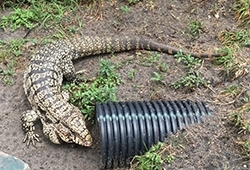NWRC Spotlight - Invasive Reptiles’ Scent Trails: New Tool for Management?

Invasive Burmese pythons and black and white Argentine tegus are well established in southern Florida. Both species’ behavior is driven by the animals’ detection and reaction to chemosensory cues, such as taste and smell.
The NWRC Florida Field Station, in cooperation with James Madison University, is examining the importance of chemosensory cues in these species, and how behavior, such as scent trailing, might be used to bolster management efforts. Scent trailing is the ability to pick up and follow a chemical odor left in passing by another animal. A recent study showed that male Burmese pythons track female scent trails, and efforts are currently underway to develop and test a pheromone-based (i.e., a chemical substance that causes a sexual response in others of the same species) python lure to help trap the snakes. A similar investigation found that female tegus track males during the breeding season. Because breeding female tegus are the drivers of this species’ populations, NWRC researchers highlight that the identification and development of a male-based scent lure could reduce populations by more efficiently removing breeding females from the landscape.
For more information, please contact nwrc@usda.gov.

